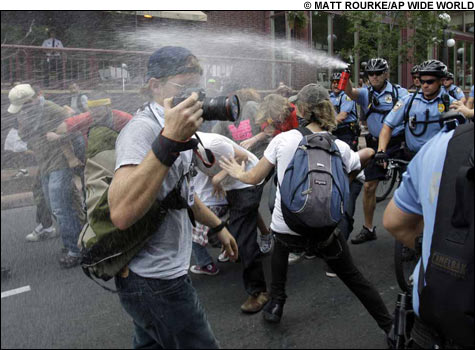
Police use pepper spray to break up a group of protesters during a rally at the Republican National Convention in St. Paul, Minn., Monday, Sept. 1, 2008. (AP Photo/Matt Rourke) |
ST. PAUL, MINNESOTA — Since 11 am on Tuesday, September 2, the first (albeit rejiggered) full day of the Republican National Convention (RNC), masses of cops indistinguishable from one another had suited up in riot gear pulled from the backs of open Ford Expeditions. Now, they were forming a thick perimeter around the St. Paul Capitol grounds, where happy young people had gathered to listen to bands, flirt, and trade colorful flyers advertising varieties of social justice. These men were dressing for a specific kind of evening on the town, and by 8:30, they were hot and bothered. Had they gotten all dressed up with no place to go?
They’d seen action the night before, of course, with 284 arrests, and in raids for several days beforehand. Millions of bucks in federal funds had been shelled out for their new gear, along with a massive insurance policy to cover lawsuits in the event of misuse. But having trailed a march for several hours to a downtown location in front of Mickey’s Dining Car, the officers were ready for more.
That’s when the rumbling began. Not low stomach rumbling, a literary device conveying impending danger. This was the sound of motors rumbling. From snowplows, dump trucks, massive city vehicles. The trucks were establishing a blockade on the dark summer streets of my hometown, forming the outer barricade in a series of three impasses — the two others created by rows of riot cops — penning in politically engaged Americans.
Confused, hungry, and with a sudden awareness that conspiracy to document a riot might be considered a felony under Minnesota’s USA PATRIOT Act, I headed in the opposite direction for dinner, hoping to meet along the way with an exhausted videographer whose two camera people were still in jail. A young girl walking nearby turned to me. “I’m not a protester,” she explained. She was heading to the capitol to sit on the grass to rest.
Clearly, she’s from here, I thought: that’s exactly the kind of boring night I used to have in this town when I was her age.
I turned off toward the restaurant and gasped. Around the corner, a constantly replenishing row of fresh riot cops was marching — goose-stepping, even — up the center of Robert Avenue, in perfect formation. Perhaps 200 went by as I stood, open-mouthed gaping. It dawned on me that I had grown up in what is now a police state. And that that poor girl was not going to enjoy another boring night in St. Paul.
The Battle of Mickey’s Diner
From downtown, shots rang out. Three of them, right in a row. I texted the friends most likely to be caught up in any trouble; it was too long before I heard back. Finally, I received a text message from a photographer: “Getting tense by the diner,” it read.
By the next morning, the scene he was referring to would be known as the Battle of Mickey’s Diner. A breakout march had been swarmed upon and surrounded by hundreds of riot police near Mickey’s Dining Car, a downtown pre-fab Art Deco restaurant some 70 years old, pictured in films like The Mighty Ducks and A Prairie Home Companion, now a symbol of lost innocence. Although only 56 arrests were made, they followed a lengthy standoff between aggressive officers and largely peaceful protesters, whose primary acts of dissent were voicing insults.
The staggering display of force had gathered before any violence had occurred. In front of Mickey’s, dispersal orders were given, and the use of weapons threatened — but for hours no exits were open to marchers. One activist in a wheelchair was tear-gassed. As another protester put it, “It was terrifying. They offered us no way out.”
The Battle of Mickey’s Diner was one of many sites in St. Paul that saw the use of Triple Chaser grenades (the source of the popping sound I heard — the grenades are described by makers Defense Technology as having the potential to cause “serious damage to property” and “injury or death”), 40 mm Direct Impact rounds, pepper spray, Tasers, smoke bombs, mace, brand-new $650 Trek mountain bikes (if you’re confused why these might be listed in a manifest of weapons, you haven’t seen the video footage of officers rearing up on them and ramming into victims), and tactical training costing approximately $50 million received in a grant from the Department of Justice. Another deal netted the city an insurance policy whereby the Republican Host Committee would pay out the first $10 million to litigants for civil-rights violations — a number twice what other cities hosting RNCs have paid.